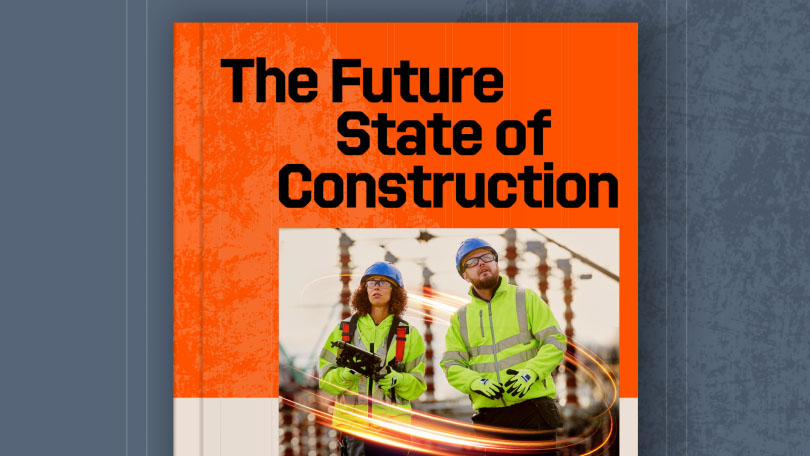— 10 min read
Unravelling the Golden Thread: BSA Compliance as Opportunity


Last Updated Aug 28, 2025

Brett King
Director of Industry Transformation, EMEA
Brett King is a construction industry transformation leader with over 15 years' experience delivering major projects and driving operational excellence across the UK and EMEA. As Director of Industry Transformation at Procore, he helps clients tackle complex challenges—from regulatory compliance and digital adoption to data strategy, AI integration, and change management at scale. With a background in business improvement and tech implementation at leading contractors, Brett bridges site-level realities with strategic outcomes—translating vision into action. A regular speaker, workshop facilitator, and trusted advisor, he’s known for making the complex simple and the theoretical practical. When he’s not driving change in construction, he’s driving greens, chasing Strava segments, or finding the best thing on the menu.

Anna K. Cottrell
Writer and Editor
Anna K. Cottrell is a writer and researcher with an expertise in the property and finance sectors.

Zoe Mullan
27 articles
Zoe Mullan is an experienced content writer and editor with a background in marketing and communications in the e-learning sector. Zoe holds an MA in English Literature and History from the University of Glasgow and a PGDip in Journalism from the University of Strathclyde and lives in Northern Ireland.
Last Updated Aug 28, 2025

The 'golden thread of information' forms the cornerstone of the Building Safety Act. Rather than serving justas a crucial compliance element, this requirement signals the start of a profound digital shift in how we manage and interact with buildings across their lifecycle. Far from being just a compliance tick box, this move toward digitisation presents the construction industry with an opportunity to build better.
Mounting evidence reveals that accidental non-compliance with the ‘golden thread’ requirement has become widespread. This stems largely from the fact that industry professionals do not fully understand or appreciate the benefits of keeping a live digital record of a building. Too many still treat compliance as a handover chore, not a live process.
Table of contents
Understanding the Digital Twin Concept
Think of a 'golden thread' as an evolving 'digital twin' of a building. When contractors scramble to assemble "as-built" documentation at the eleventh hour, they have already failed the 'golden thread' test. This reactive approach creates significant risks.
The consequences of omitting even seemingly inconsequential details and design changes are severe:
- An incomplete digital thread creates confusion when teams share documentation with stakeholders
- A patchy record of building changes can land clients in legal trouble with the Building Safety Regulator (BSR)
Industry Knowledge Gaps
Despite the severity of potential consequences, recent research by the Construction Leadership Council (CLC)reveals concerning statistics about industry understanding:
- 92% of product manufacturers “do not see digitisation as a major concern” and more than half “see no need to digitise”
- 85% of companies email PDF documents or send hard copies only
- Only 8% have ever made or commissioned a Building Information Modelling (BIM) object
- Most survey respondents could not define digitisation accurately
This demonstrates a dangerous lack of awareness about the long-term consequences of having product data that cannot be digitised: no spec; no assurance; no reuse.
Breaking Down Traditional Silos
While legal compliance alone justifies taking digitisation seriously, the golden thread's purpose extends beyond stricter regulation enforcement – it enacts a profound shift in how building project teams collaborate. Currently, different professionals working on building projects continue to operate in siloed ways.
Traditional building projects suffer from one of the biggest problems: a lack of communication between material manufacturers, architects, engineers, construction professionals, and building owners. Historically, these groups have operated as distinct and separate teams that rarely communicate throughout the project and fail to share crucial structural information. This fragmented approach eventually impacts the building's entire lifecycle.
Consider this scenario: How will a landlord or building management company know that teams decided to use cheaper, inappropriate materials for fire doors without a detailed information handover? Conversely, if a building owner or manager replaces a fire-critical feature without recording the change, who will know about modifications to the building once it's in use?
Defining Responsibilities
A 'golden thread of information' creates a digital trail of documentation, decisions, and data for a building, from design to handover and beyond.
The BSR clearly defines the chain of responsibility for such a digital trail. During the design and construction phase, ultimate responsibility for creating and maintaining the golden thread lies with the client. Many clients mistakenly assume contractors or consultants handle this task. The central takeaway here: 'Just because you've procured it, doesn't mean it's managed.'
Pro Tip
The client must ensure teams securely store information and share it with every designer and contractor working on the project. Crucially, clients must initiate the golden thread at the very beginning of the project, before the design stage begins.
Design and Construction Phase Responsibilities
Throughout the design and construction stages, the Principal Designer (PD) and Main Contractor (MC) are responsible for keeping meticulous records of all information relevant to the building work. In practice, this means the PD and MC must maintain regular communication and share all changes with all members of both teams.
Handover and Operational Phase
Once building work completes, the client applies for a completion certificate from the BSR. To receive this certificate, the client must demonstrate that they have shared the ‘golden thread’ with the Principal Accountable Person for the building. The Principal Accountable Person assumes responsibility for maintaining and repairing a high-rise residential building's common areas. Typically, this will be the building's freeholder or landlord.
After the completion certificate issues and the building becomes ready for occupancy, the Principal Accountable Person must maintain records of any refurbishments, inspections, and health and safety files for the building. Multiple accountable persons may exist throughout the building's lifecycle, but one Principal Accountable Person must always remain responsible for keeping the digital record up-to-date.
Beyond Compliance: Unlocking Value
The benefits of implementing the 'golden thread' framework extend well beyond simply complying with the Building Safety Act's requirements and avoiding financial and legal repercussions.
Done right, the golden thread is the foundation of a building's digital twin – a living, breathing model of the asset that evolves from design to demolition. Think Google Maps, but for your building: always available, constantly updated, with layers of intelligence that tell you what's there, what's changed, and what needs attention. That's the future we should be building towards – not static PDF archives or isolated BIM files.

Brett King
Director of Industry Transformation, EMEA
Procore Technologies
Streamlined Communication
One of the most obvious and significant benefits of maintaining a 'golden thread' – which impacts every stage in the building's lifecycle – involves streamlining communication between different teams working on the building's design, construction, and eventual maintenance. Traditionally, lack of communication has been one of the biggest factors in inadequate building safety. While most poor communication stems from misalignments in working cultures, occasional breakdowns in trust result in different project teams avoiding communication entirely.
A 'golden thread' ensures that all parties possess a copy of the living digital record of the building. Teams cannot restrict changes and updates to just one group, which eliminates the potential for vital safety data being omitted or lost. From any team's perspective, continuing work on a project becomes much easier with correct information always at hand, rather than redirecting time and effort to tracking down missing relevant data.
Enhanced Building Management
This move toward full and evolving digitisation provides value for building owners because future maintenance and renovations become much easier to plan, budget for, and execute with precise knowledge of the structural design and materials originally used.
Insurance Benefits
Building insurers undoubtedly view robust digital documentation as a crucial factor in their decision-making processes. Non-compliant or insufficient information, under the new regulations, makes insurers much more vulnerable to claims. The BSA has significantly extended the timeframe for historical defect insurance claims, making the 'golden thread' essential to satisfy insurers.
Protracted claims resulting from fire safety investigations by the BSR represent a significant risk insurers want to avoid. For example, a recent case involved a protracted claim by a higher-risk building (HRB) owner with a pending gateway application for improvements with the BSR. The application was filed after a water leak triggered a fire safety notice with the subsequent evacuation of all residents. BSR ultimately rejected the application 1.5 years later, naming 'insufficient, generic, and unrealistic' documentation as the main reason. Meanwhile, the insurer had been paying $100k+ per month to house the displaced residents.
The case clearly demonstrates that robust, up-to-date, and transparent documentation would have prevented the entire chain of events. The absence of a single, searchable, live information source directly caused the delays and costs. If a ‘golden thread’ had been in place – built like a Google Maps layer – the whole situation could have been pre-empted.
Everyone suffers from the lack of an adequate digital record:
- The residents who had to be evacuated from an unsafe building
- The building owner who now has a building that's been uninhabited for several years
- The insurer who had to foot the bill
- Future building owners who will have to contend with wary insurers and increased premiums
Implementation Strategies
Key questions remain for many clients and teams: What are the best-practice frameworks for creating and maintaining a 'golden thread of information? How does a 'golden thread' differ from simply having digital copies of documents or a spreadsheet?
Answering these questions becomes easier when considering the main goals of the 'golden thread' system:
- Make all building information secure
- Ensure changes are trackable
- Centralise data for easy access
Teams cannot achieve these goals by merely storing data – success requires proper data structuring. Creating a building's 'digital twin' requires standardised, machine-readable, time-stamped data.
What Doesn’t Work
Some digital record-keeping methods, like scanning and emailing documents, obviously fail on all fronts: they lack security, standardisation, and easy tracking (an email with a PDF can very easily be deleted, not sent to all the correct people, etc.). Others appear to offer improvement but still fall short in one or both parameters. Spreadsheets, for example, prove notoriously prone to human error, resulting in inaccurate record-keeping.
BIM Modelling: A Key Solution
A crucial part of the solution – which Dame Hackitt's original pre-BSA report recommended – involves BIM modelling. Teams achieve BIM modelling by creating a 3D map of a building using lasers. This process works for both new and existing buildings, proving highly accurate and secure whilst allowing for easy sharing of precise data points. To illustrate, every fire door in a building can receive its own BIM data pin, making the location of a specific door within a building a matter of seconds. If the door ever suffers destruction, in a fire or otherwise, a precise record of its existence will remain. The evolution of BIM modelling moves the BIM model out of just the design phase and into construction and Operations/Facilities Management.
However, BIM is not infallible – experts still consider it relatively new technology, with low industry uptake. Some concerns have also been voiced about certain information still not making it onto BIM records because firms try to keep proprietary information private. Nevertheless, it remains a much better system to work with than manual, non-visual record-keeping. BIM serves as good input, but not the final product. A 'digital twin' requires operational data, not just design.
Technology Solutions
Another important technological solution to common centralisation and data-sharing problems comes in the form of synchronisation software. This type of software ensures that teams always make the entire data trail available to all parties, regardless of who makes the changes. This eliminates the possibility that someone at some stage in the process will remain uninformed.
Of course, automation cannot entirely replace human oversight. Each project team could benefit from appointing 'data champions' who would manage the living document, keeping meticulous records of different versions and access.
Practical Guidelines
Best Practices
Project teams should implement the following steps to ensure 'golden thread' compliance:
- Maintain consistent naming conventions
- Store data in secure but accessible platforms
- Track design changes meticulously
Common Pitfalls to Avoid
Avoiding the following practices will help prevent miscommunication and non-compliance issues:
- Don't wait until final project stages to compile data
- Don't allow multiple uncoordinated systems that lead to lost information
From Compliance to Innovation
The 'golden thread' isn't the finish line – it's the starting point. When teams implement it properly, it becomes the foundation of a true 'digital twin': a dynamic, interactive record of your building that evolves over time. If BIM gives a snapshot at design, the digital twin provides the live feed – enriched with real-time updates, maintenance records, and even sensor data. It represents the construction industry's equivalent of Google Maps: familiar, functional, and always a tap away. That's where the 'golden thread' should lead us – if we stop treating it as a filing exercise and start viewing it as a performance platform.
The golden thread isn't just for regulators – it marks the start of a smarter way to deliver, operate, and understand the built world. If compliance is the carrot, the real prize is a usable, ever-evolving digital double: one that lives, learns, and becomes essential to the built environment.
For many building teams, a key difficulty in building an accurate building record lies in the confusion about what constitutes a higher-risk building in the first place. Read our next article to discover the current nuances of the HRB definition and their impact on the construction industry.
Categories:
Written by

Brett King
Director of Industry Transformation, EMEA | Procore Technologies
Brett King is a construction industry transformation leader with over 15 years' experience delivering major projects and driving operational excellence across the UK and EMEA. As Director of Industry Transformation at Procore, he helps clients tackle complex challenges—from regulatory compliance and digital adoption to data strategy, AI integration, and change management at scale. With a background in business improvement and tech implementation at leading contractors, Brett bridges site-level realities with strategic outcomes—translating vision into action. A regular speaker, workshop facilitator, and trusted advisor, he’s known for making the complex simple and the theoretical practical. When he’s not driving change in construction, he’s driving greens, chasing Strava segments, or finding the best thing on the menu.
View profile
Anna K. Cottrell
Writer and Editor | Freelance
Anna K. Cottrell is a writer and researcher with an expertise in the property and finance sectors.
View profileReviewed by

Zoe Mullan
27 articles
Zoe Mullan is an experienced content writer and editor with a background in marketing and communications in the e-learning sector. Zoe holds an MA in English Literature and History from the University of Glasgow and a PGDip in Journalism from the University of Strathclyde and lives in Northern Ireland.
View profileExplore more helpful resources

Control the Chaos: Standardising Document Workflows in Construction Projects
Document control and implementation play a central role in managing risk, meeting deadlines, and delivering projects to spec. As builds become more complex and teams increasingly disperse, the volume and...

Cost-Plus Construction Contracts in the UK
A construction cost-plus contract – sometimes called a cost-reimbursable or prime cost contract – reimburses all project costs and adds a fee to cover the contractor’s overhead and profit. UK...

Digital Construction Technology for Whole-Life Value
For decades, the construction industry has kept a narrow focus on capital cost — the one-time, upfront costs of a construction project. While in the short term this seems like...

UK Construction Progress Reports: Tools for Smarter Site Management
Construction progress reports track completed work, on site issues, costs, and safety so UK project teams can demonstrate progress, secure payments, and stay on programme. Accurate progress data is essential...
